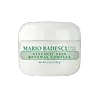What's inside
What's inside
 Key Ingredients
Key Ingredients

 Benefits
Benefits

 Concerns
Concerns

 Ingredients Side-by-side
Ingredients Side-by-side

Water
Skin ConditioningArachis Hypogaea Oil
Skin ConditioningGlycerin
HumectantDimethicone
EmollientPropylene Glycol
HumectantCetyl Alcohol
EmollientMyristyl Myristate
EmollientCetearyl Alcohol
EmollientGlycolic Acid
BufferingGlyceryl Stearate
EmollientPEG-100 Stearate
Sodium Carboxymethyl Beta-Glucan
CleansingCarica Papaya Fruit Extract
Skin ConditioningMica
Cosmetic ColorantZea Mays Oil
EmulsifyingHoney Extract
HumectantChitosan Succinamide
Spiraea Ulmaria Extract
AstringentRetinyl Palmitate
Skin ConditioningGlyceryl Acrylate/Acrylic Acid Copolymer
HumectantButylene Glycol
HumectantCeteareth-20
CleansingParfum
MaskingPhenoxyethanol
PreservativeMethylparaben
PreservativePropylparaben
PreservativeDiazolidinyl Urea
PreservativeImidazolidinyl Urea
PreservativeCitronellol
PerfumingWater, Arachis Hypogaea Oil, Glycerin, Dimethicone, Propylene Glycol, Cetyl Alcohol, Myristyl Myristate, Cetearyl Alcohol, Glycolic Acid, Glyceryl Stearate, PEG-100 Stearate, Sodium Carboxymethyl Beta-Glucan, Carica Papaya Fruit Extract, Mica, Zea Mays Oil, Honey Extract, Chitosan Succinamide, Spiraea Ulmaria Extract, Retinyl Palmitate, Glyceryl Acrylate/Acrylic Acid Copolymer, Butylene Glycol, Ceteareth-20, Parfum, Phenoxyethanol, Methylparaben, Propylparaben, Diazolidinyl Urea, Imidazolidinyl Urea, Citronellol
Alternatives
Ingredients Explained
These ingredients are found in both products.
Ingredients higher up in an ingredient list are typically present in a larger amount.
Glycolic Acid is arguably the most famous alpha hydroxy acid (AHA) with tons of research backing its benefits.
It is found naturally in sugar cane but the form used in skincare is usually synthetic for purity and stability.
Glycolic acid removes the top layer of dead skin cells to allow newer and fresher ones to emerge.
AHAs work by breaking down the structural “glue” that holds old skin cells in place. When that buildup is gone, your skin can renew itself more efficiently.
Research also shows glycolic acid stimulates collagen production, helping to firm and thicken the skin over time. This is one of its biggest advantages over other AHAs.
Overall, glycolic acid helps with:
Fun fact: Glycolic acid boosts skin hydration by helping it produce molecules that increase hyaluronic acid naturally.
To work best, glycolic acid products should have a pH between 3-4 (that’s where exfoliation is most effective but still gentle on skin).
The pH and concentration of a product are key to its effectiveness:
It is normal to feel a slight stinging sensation when using glycolic acid. This usually fades as your skin adjusts.
Because glycolic acid has the smallest molecular size in the AHA family, it can penetrate deeper, which enhances its effectiveness but also makes it more likely to irritate sensitive skin.
If your skin is very sensitive or prone to rosacea, glycolic acid may be too strong; in that case, try milder options like lactic acid or a PHA instead.
Recent studies suggest glycolic acid might even help protect against UV damage. But don’t skip sunscreen! Freshly exfoliated skin is more sensitive to the sun.
Glycolic acid is a skincare superstar. It smooths, brightens, hydrates, and firms the skin. Unless you’re highly sensitive, it’s well worth adding to your routine.
Read more about some other popular AHA's here:
Learn more about Glycolic AcidImidazolidinyl Urea is a preservative and isn't fungal acne safe. It can cause irritation and worsen eczema.
Retinyl palmitate is a form of retinoid. Retinoids are the superstar class of anti-aging ingredients that include tretinoin and retinol.
This particular ingredient has had a bumpy year with its rise and fall in popularity.
First, Retinyl palmitate is created from palmitic acid and retinol. It is a retinol ester and considered one of the weaker forms of retinoid.
This is because all retinoids have to be converted to Tretinoin, AKA retinoic acid. Retinyl Palmitate is pretty far down the line and has to go through multiple conversions before its effects are seen.
Due to this long and ineffective conversion line, the benefits of Retinyl Palmitate are debated.
Studies show Retinyl Palmitate to help:
Dermatologists say this ingredient is ineffective because it isn't used in high enough concentrations in cosmetics.
This ingredient used to be found in sunscreens to boost the efficacy of sunscreen filters.
The downfall of Retinyl Palmitate was due to released reports about the ingredient being correlated to sun damage and skin tumors.
While there is a study showing this ingredient to cause DNA damage when exposed to UV-A, there is no concrete proof of it being linked to skin cancer. It is safe to use when used correctly.
All retinoids increase your skin's sensitivity to the sun in the first few months of usage. Be especially careful with reapplying sunscreen when using any form of retinoid.
Currently, this ingredient is still allowed in cosmetics all over the world. In Canada, cosmetics must have a warning label stating the product to contain Retinyl Palmitate
Fun fact: This ingredient is often added to low-fat milk to increase the levels of Vitamin A.
Learn more about Retinyl PalmitateWater. It's the most common cosmetic ingredient of all. You'll usually see it at the top of ingredient lists, meaning that it makes up the largest part of the product.
So why is it so popular? Water most often acts as a solvent - this means that it helps dissolve other ingredients into the formulation.
You'll also recognize water as that liquid we all need to stay alive. If you see this, drink a glass of water. Stay hydrated!
Learn more about Water